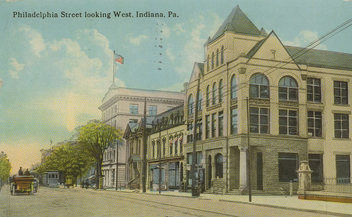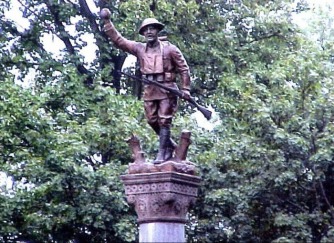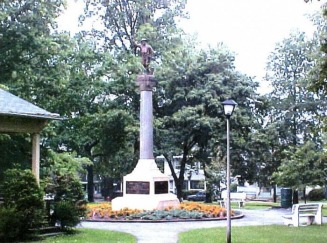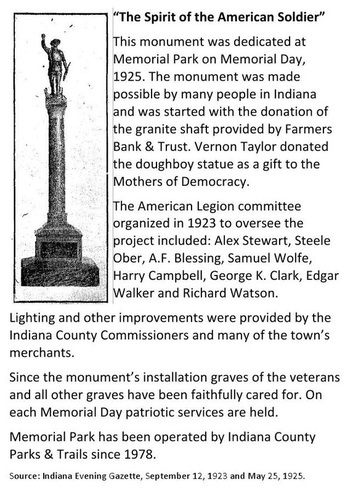Photos provided by Scott Decker and Barb Waltemire, Indiana County Historical and Genealogical Society.
INDIANA, PENNSYLVANIA
N 40° 37.166 / W79° 9.075
Copyright version 1920, sheet bronze.
Smithsonian Art Inventory Control Number: PA001460.
Copyright version 1920, sheet bronze.
Smithsonian Art Inventory Control Number: PA001460.
In impressive memorial park next to the Silas Clark House facility of the Historical & Genealogical Society of Indiana County at 200 South Sixth Street.
Although the Smithsonian IAS record is correct, it doesn't identify Viquesney as the sculptor.
Although the Smithsonian IAS record is correct, it doesn't identify Viquesney as the sculptor.
The plaque inscription on the front of the 30 foot pedestal reads:
INDIANA MEMORIAL
IN HONOR OF THE MEN AND WOMEN WHO SERVED THEIR COUNTRY
DURING THE WORLD WAR 1917 – 1918
---------
SACRED TO THE MEMORY OF THOSE WHO DIED
FOR LIBERTY, UNION, JUSTICE AND PEACE
(followed by names of those who died in the World War,
Spanish American War, Civil War, and Revolution.)
INDIANA MEMORIAL
IN HONOR OF THE MEN AND WOMEN WHO SERVED THEIR COUNTRY
DURING THE WORLD WAR 1917 – 1918
---------
SACRED TO THE MEMORY OF THOSE WHO DIED
FOR LIBERTY, UNION, JUSTICE AND PEACE
(followed by names of those who died in the World War,
Spanish American War, Civil War, and Revolution.)
A plaque on the rear of the base honors the men and women of Indiana County who served during World War II and the 385 who gave their lives. A plaque on the Doughboy’s left side of the base honors those who served in Korea and Vietnam and those who gave their lives.
Recently (as of this writing, March, 2011) a new plaque has been placed nearby. It reads:
Recently (as of this writing, March, 2011) a new plaque has been placed nearby. It reads:
The title "The Spirit of the American Soldier" was chosen because the original 1923 committee wanted a monument to honor the soldiers of all America's wars, so that's what they called it. But as my site colleague the late Earl Goldsmith pointed out, anyone willing to climb the 30-foot pillar (don't do it!) will see "Spirit of the American Doughboy" embossed on the base. (A much better idea would be to photograph the title plate with a telephoto lens!)
 Photo: Collection of Indiana County historian John Busovicki.
Photo: Collection of Indiana County historian John Busovicki.
The column upon which the Doughboy stands was originally part of the old Farmers' Bank building on Philadelphia Street. It appears to be the one visible at the corner of the building in this old postcard view.
The Doughboy was dedicated May 30, 1925 after having already been in Indiana for quite a period of time, possibly as early as late 1923. Some rather storied controversial events related to its acquisition are summarized below.
The Doughboy is located on land what was once part of an old cemetery that had burials dating from as early as 1803 to 1875 - and there are still graves in the area. A Lutheran church group had acquired the area by gift from its original owner and began constructing a church but ran short of funds. It planned to sell the trees and part of the land to finance the building on another part. The local veterans opposed the idea of selling the land and placing the church on the rest, and mounted a campaign to erect a memorial on the property. The person who was apparently the most active in the campaign was Alex Stewart, a local hardware merchant, and the father of screen actor Jimmy Stewart. A local bank made a gift of the tall impressive pedestal to the Mothers of Democracy in 1922 and a local individual made a gift of the Doughboy sculpture.
The Mothers of Democracy enlisted the aid of the American Legion and Alex Stewart became more heavily involved than he had been previously, to the point of becoming the monument committee chairman. He, his teen-aged son, Jimmy, and a group of Stewart’s interested associates began digging a hole for the pedestal’s foundation. That night, the church group, apparently concerned that the erection of the memorial would reduce the price they could get for the land, filled the hole. Stewart, Jimmy and the others dug the hole again and the church group filled it again. That time, they erected a fence and posted a no trespassing sign. Stewart invited his associates and members of the church group to meet him at the site and when the group was assembled, cut the fence, crossed into the area and defied anyone to do anything about it. Stories in Indiana differ as to whether he spent time in jail, and if so, how much. In the end, the city bought the land and the Doughboy was erected where Stewart and his associates had wanted it to be placed. More on the controversy can be found at this Rootsweb site.
The Doughboy and park were rededicated in October 2000 following a major refurbishment.
Thanks to Kevin White, Associate Editor of the Historical Marker Database for the Rootsweb link.
The Doughboy is located on land what was once part of an old cemetery that had burials dating from as early as 1803 to 1875 - and there are still graves in the area. A Lutheran church group had acquired the area by gift from its original owner and began constructing a church but ran short of funds. It planned to sell the trees and part of the land to finance the building on another part. The local veterans opposed the idea of selling the land and placing the church on the rest, and mounted a campaign to erect a memorial on the property. The person who was apparently the most active in the campaign was Alex Stewart, a local hardware merchant, and the father of screen actor Jimmy Stewart. A local bank made a gift of the tall impressive pedestal to the Mothers of Democracy in 1922 and a local individual made a gift of the Doughboy sculpture.
The Mothers of Democracy enlisted the aid of the American Legion and Alex Stewart became more heavily involved than he had been previously, to the point of becoming the monument committee chairman. He, his teen-aged son, Jimmy, and a group of Stewart’s interested associates began digging a hole for the pedestal’s foundation. That night, the church group, apparently concerned that the erection of the memorial would reduce the price they could get for the land, filled the hole. Stewart, Jimmy and the others dug the hole again and the church group filled it again. That time, they erected a fence and posted a no trespassing sign. Stewart invited his associates and members of the church group to meet him at the site and when the group was assembled, cut the fence, crossed into the area and defied anyone to do anything about it. Stories in Indiana differ as to whether he spent time in jail, and if so, how much. In the end, the city bought the land and the Doughboy was erected where Stewart and his associates had wanted it to be placed. More on the controversy can be found at this Rootsweb site.
The Doughboy and park were rededicated in October 2000 following a major refurbishment.
Thanks to Kevin White, Associate Editor of the Historical Marker Database for the Rootsweb link.







